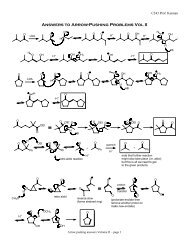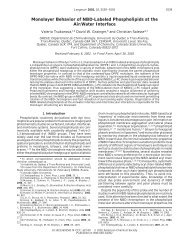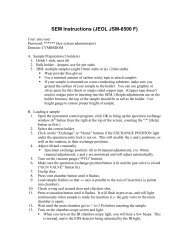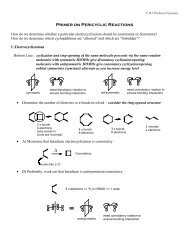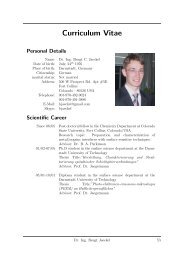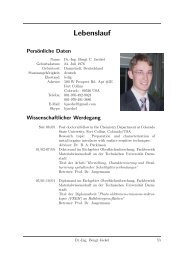Message from the Chair - Department of Chemistry - Colorado State ...
Message from the Chair - Department of Chemistry - Colorado State ...
Message from the Chair - Department of Chemistry - Colorado State ...
Create successful ePaper yourself
Turn your PDF publications into a flip-book with our unique Google optimized e-Paper software.
The department welcomes...<br />
The department welcomes.....<br />
Dr. Chris Ackerson (Fall 2009)<br />
Dr. Ackerson joined <strong>the</strong> faculty <strong>of</strong> CSU’s chemistry department in <strong>the</strong> Fall <strong>of</strong> 2009.<br />
His research is focused at <strong>the</strong> interface <strong>of</strong> inorganic nanoparticle chemistry and biology. To<br />
this end, his research group endeavors to both make nanoparticles that can effect or reveal<br />
biological processes, especially disease processes, as well as harness biological processes to<br />
syn<strong>the</strong>size novel inorganic clusters and nanoparticles. The group currently comprises one<br />
postdoc, one graduate student and one technician. In addition to starting <strong>the</strong> lab, Dr. Ackerson<br />
teaches Inorganic Syn<strong>the</strong>sis and is active on <strong>the</strong> Graduate Admissions Committee. Dr.<br />
Ackerson was born in Boulder, <strong>Colorado</strong>, grew up in Stillwater, Oklahoma, and earned a<br />
bachelor’s degree with honors at <strong>the</strong> University <strong>of</strong> Texas–Austin where he completed a Special<br />
Honors Thesis in <strong>Chemistry</strong> under <strong>the</strong> supervision <strong>of</strong> Tom Kodadek. He pursued PhD studies<br />
at Stanford University under Roger Kornberg, <strong>the</strong> 2006 Nobel Laureate in <strong>Chemistry</strong>, where he<br />
developed new gold cluster syn<strong>the</strong>tic strategies for application to biological electron<br />
microscopy. Immediately prior to joining <strong>the</strong> faculty at CSU, Dr. Ackerson worked as a postdoc<br />
in <strong>the</strong> lab <strong>of</strong> CSU <strong>Chemistry</strong> alumnus Pr<strong>of</strong>essor Dan Feldheim, at <strong>the</strong> University <strong>of</strong> <strong>Colorado</strong><br />
in Boulder, where he worked on genetically encodable nanoparticles.<br />
Dr. Brian McNaughton (Fall 2009)<br />
Dr. McNaughton joined <strong>the</strong> <strong>Chemistry</strong> <strong>Department</strong> at CSU in <strong>the</strong> fall <strong>of</strong> 2009, and<br />
currently oversees a lab <strong>of</strong> seven postdoctoral, graduate, and undergraduate researchers. Research<br />
efforts in <strong>the</strong> McNaughton group are multidisciplinary, but focus on small molecule-dependent<br />
regulation <strong>of</strong> RNA biochemistry; inhibition <strong>of</strong> protein-protein interactions; targeted delivery <strong>of</strong><br />
<strong>the</strong>rapeutic and bio-imaging reagents; and novel biopolymer chemistry. Members <strong>of</strong> <strong>the</strong><br />
McNaughton group address <strong>the</strong>se challenges using methods in organic syn<strong>the</strong>sis, combinatorial<br />
chemistry, molecular biology, and cell biology, in <strong>the</strong> context <strong>of</strong> high-throughput screening and<br />
evolution-based selections. Brian received his Ph.D. <strong>from</strong> <strong>the</strong> University <strong>of</strong> Rochester under <strong>the</strong><br />
direction <strong>of</strong> Benjamin Miller, where he worked on methods for small molecule evolution and small<br />
molecule - RNA interactions. He <strong>the</strong>n conducted postdoctoral research as a Howard Hughes<br />
Medical Institute fellow at Harvard University, where he worked on protein engineering under <strong>the</strong><br />
direction <strong>of</strong> David Liu. Shortly after arriving to CSU Brian received a CDMRP New Investigator<br />
Award <strong>from</strong> <strong>the</strong> <strong>Department</strong> <strong>of</strong> Defense.<br />
Dr. Amber Krummel (Fall 2010)<br />
Dr. Krummel, who is originally <strong>from</strong> <strong>the</strong> Northwest, completed her Bachelor’s in<br />
<strong>Chemistry</strong> at Portland <strong>State</strong> University in Portland, Oregon. Dr. Krummel <strong>the</strong>n moved to<br />
Madison, WI to pursue graduate studies at <strong>the</strong> University <strong>of</strong> Wisconsin—Madison. Dr.<br />
Krummel earned her Ph.D. in Physical <strong>Chemistry</strong> under <strong>the</strong> guidance <strong>of</strong> Pr<strong>of</strong>. Martin Zanni.<br />
Her graduate work focused on developing 2D IR spectroscopy as a tool for investigating <strong>the</strong><br />
structure and dynamics <strong>of</strong> DNA. Upon completing her Ph.D., Dr. Krummel moved to<br />
Cambridge, Massachusetts, where she worked as a Postdoctoral Fellow in <strong>the</strong> Weitz lab at<br />
Harvard University. In July 2010, Dr. Krummel relocated to Fort Collins to join <strong>the</strong> <strong>Chemistry</strong><br />
Faculty at <strong>Colorado</strong> <strong>State</strong> University. Research in Dr. Krummel’s lab will focus on elucidating<br />
<strong>the</strong> molecular level details that drive nano- to microscopic properties in condensed phase<br />
systems. Initially, our group will exploit <strong>the</strong> structural and temporal resolution <strong>of</strong> twodimensional<br />
infrared spectroscopy to address questions related to pore-formation in lipid<br />
membranes, charge transport in polyelectrolyte membranes, and <strong>the</strong> nano-aggregation process<br />
<strong>of</strong> asphaltenes.<br />
4



